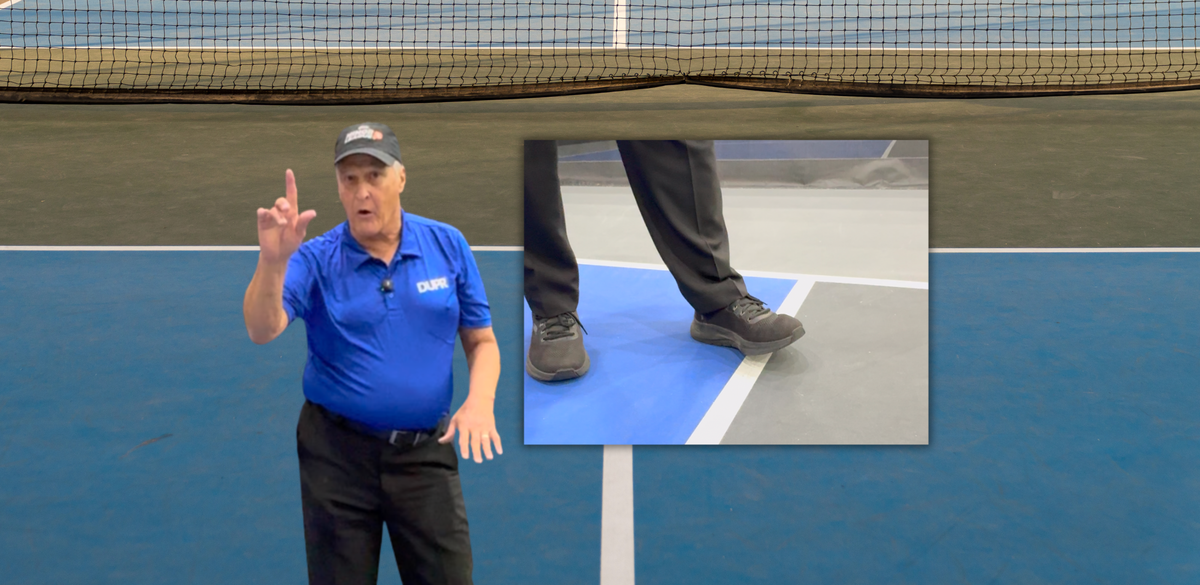
In pickleball, when a ball is hit low to you up at the non-volley zone, the standard play is usually a return dink or maybe a low volley. These are high-percentage plays, but sometimes you can mix in some deceptive or aggressive shots to surprise your opponents when they’re at the kitchen. These shots require more skill than your regular dinks, volleys, and groundstrokes. You’ll need to put in some practice time not only to perfect your technique but also to disguise your intentions. So, let’s take a look at how you can mix up your game and keep those other guys guessing.
Dead Dink
First, keep in mind that you need to find the right ball to attack—namely, what I call a dead dink. This is when the ball is hit medium depth in the kitchen with a nice bounce, so it sits up a bit in front of you (Figure 1).

When this happens, try to contain your excitement and make your shot look like a dink until the last second. Your goal is to disguise and surprise. When attacking a low ball with both teams at the kitchen, it’s best to go after the player in front of you or split your opponents with an aggressive shot. These shots are the flick, the drive, and the roll or rollover.
Flick
The flick uses almost no backswing as you flick the paddle with a short snapping motion, sending the ball at the upper body of your counterpart. Yes, you’re often trying to hit the other player, and this is perfectly acceptable in competitive or tournament pickleball (Figure 2). Just make sure it’s okay with the rest of your group when playing for fun—you don’t want Gretchen keying your car in the parking lot afterward.
This ball isn’t hit too hard, so even if you hit your buddy up high, they should survive the experience. However, this is one more reason to wear protective eyewear when you play.

The Drive
You can also drive the ball into your opponent’s body with an aggressive stroke designed to beat their reaction time. You’re not necessarily trying to keep the ball on the court; you’re just trying to catch a piece of their paddle or body. The best place to aim your attack is the hip and armpit area of their dominant side, forcing them to chicken wing with their backhand or awkwardly flip their paddle to their forehand. Be careful when driving the ball directly at their paddle, or you may get counter-attacked by a skilled opponent.
The Rollover
If you’re a kinder, gentler soul and prefer your winners with a minimum of pickleballs bouncing off your friends, then you can use the rollover shot. This shot is usually played down the middle and must be hit with a low to high paddle path that imparts topspin so the ball can be hit firmly enough to split your opponents but with enough overspin to bring it down into the court (Figure 3).

Don’t try to physically roll your wrist over too much, or you won’t make solid forward contact. The low to high swing path with a short to long follow-through will do the trick.
Swing Path
My wrist pushes forward right before contact and stays in that position through impact. This adds power and drives the ball low as I brush over the top of it. Also, my paddle doesn’t start much further back than the kitchen line or my hip. A bigger backswing telegraphs your intentions—for younger players, I assume it would instant message your intentions, I don’t know. One way to set up this shot is with a cross-court dink wide to the backhand that opens up the middle. Sometimes you may need to take a step back or to the side to give yourself room to execute the shot. This may reveal your intentions, but getting in good position may allow you to hit a good enough shot that it just doesn’t matter.
Drop Shot
The shots you’ve just seen are played when both teams are at the kitchen, but there’s also a deceptive shot you can play when the other team is back on the court: the drop shot. The key to making one of these shots is to make it look like a dink until it isn’t. The key to the drop shot is to make it look like a hard volley or overhead until it isn’t.
There are two situations that suit this shot well. One is when your opponent hits a hard drive from back on the court. Your goal is to take their pace and deaden the ball into the kitchen (Figure 4).

You can angle the ball off the court or drop it low with a little side spin or underspin. You want to keep your grip soft and feel like you’re almost catching the ball with your paddle. Another good time for a drop shot is when you receive a high ball that looks like it will be slammed. Show that paddle like you’re going to crush it, put on your “I’m going to pound this sucker” face, and then drop it into the kitchen like laying a baby into its crib.
To Wrap Things Up
There are other tricky moves, such as attacking with a no-look shot or twisting your paddle face at the last second to change direction. Feel free to play around with these and other fun shots. You can play with Ernie’s, go around the post, and you can look for those online to see techniques on how to do them. Just remember: don’t get too tricky and take unnecessary chances, losing points by getting caught up in hitting highlight-reel shots when really, good old basic shots are going to get it done. Deception and aggression at the kitchen add a lot of spice to your game. They keep your opponents guessing. Play the percentages, but have a little fun too because that’s what we’re all out here to do. Enjoy these shots, and I’ll see you on the courts.
Anuncie Aqui / Advertise Here
Sua marca para o mundo Pickleball! / Your brand for the Pickleball world!

 English
English  Spanish
Spanish  Portuguese
Portuguese  German
German  Italian
Italian  Japanese
Japanese  French
French  Polish
Polish  Russian
Russian  Netherlands
Netherlands  Hungarian
Hungarian  Turkish
Turkish  Videos
Videos  Pickleball Portal
Pickleball Portal








 English (US) ·
English (US) ·  Portuguese (BR) ·
Portuguese (BR) ·